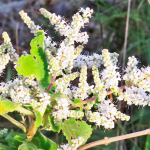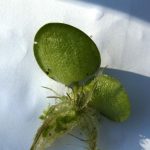TREE LIFE
June 2017
MASHONALAND CALENDAR
Depending on response from the membership, it has been proposed that as from 1st July 2017 there should only be two outings a month arranged for members. This decision has not been taken lightly, but due to ever falling attendances and difficulties in arranging outings for the 4th Saturday of the month it seemed like a good decision. If our membership grows again with enthusiastic young botanists and lovers of the bush and its flora and fauna, then we can always go back to the old system.
It’s proposed that there should be a monthly walk on the 1st Saturday of the month in the afternoon, starting at 15.45 hours in the Botanic Gardens. If some other venue becomes available, you would be advised of the time and place in the monthly newsletter and again reminded just before the event. If we were going further afield we would of course start a little earlier. We would continue to seek interesting venues for the 3rd Sunday of the month. If there are too many complaints about this new arrangement, we can easily continue with the old, tried and tested programme. Please respond to the earlier email from Tony asking for your opinion.
Outings for June 2017
Sunday June 18th: Ewanrigg National Park. Tony Alegria and Dave Hartung have done a huge amount of work on labeling the trees at Ewanrigg and preparing lists so that visitors can more easily identify them so it will be interesting to see their endeavours. In addition the aloes will be coming into bloom.
Please meet at CABS at 09.15 for a 09.30 departure for those wanting to share transport. For those travelling on their own DO NOT TAKE THE SHAMVA ROAD – the access road is impassable. Instead, from the Toll Gate, proceed for 14.6 kms straight along the Mtoko Road and you will see a homemade sign (white background with black writing) on the right hand side of the road reading something like ”The Aloe Restaurant 4.5Kms Ice & Cold Beers + braai”. Turn left onto the dirt road – the entrance to Ewanrigg Gardens is 3.8Kms along this road. Once there, turn left after the entrance and drive up to the far car park near the old water garden and café. We meet just after 10am. Bring a picnic lunch, chairs, hats etc. etc. for a good day out.
Saturday June 27th. OUTING TO THE HORNE PROPERTY, LICHENDALE, by kind permission of Pip and Nick Horne. This is an interesting garden where many indigenous trees have been planted, but the main item of interest is their water conservation/storage system. They have dug and lined a dam which will receive all the run-off from the plot and by next rainy season will collect all the water from the roof of the house as well. It has been well stocked with bream which are flourishing and is being interestingly landscaped.
Chairman’s 2016/17 report
I have pleasure in presenting my second annual Chairman’s report of the Tree Society, for the year 1 April 2016 to 31 March 2017.
The regular Tree Society series of monthly outings continued and we managed to organise ten 3rd Sunday outings. Ten of the 4th Saturday walks also took place during the year. Now that the Harare Botanical outings have been changed to a Saturday morning, we have had more tree walks mostly led by Tom Muller. Dave Hartung and others have come to our rescue when Tom was not available. One outing was rained off whilst another was not advertised and only Mary Lovemore turned up – the only person with a good memory! The outings are summarised in the following table:
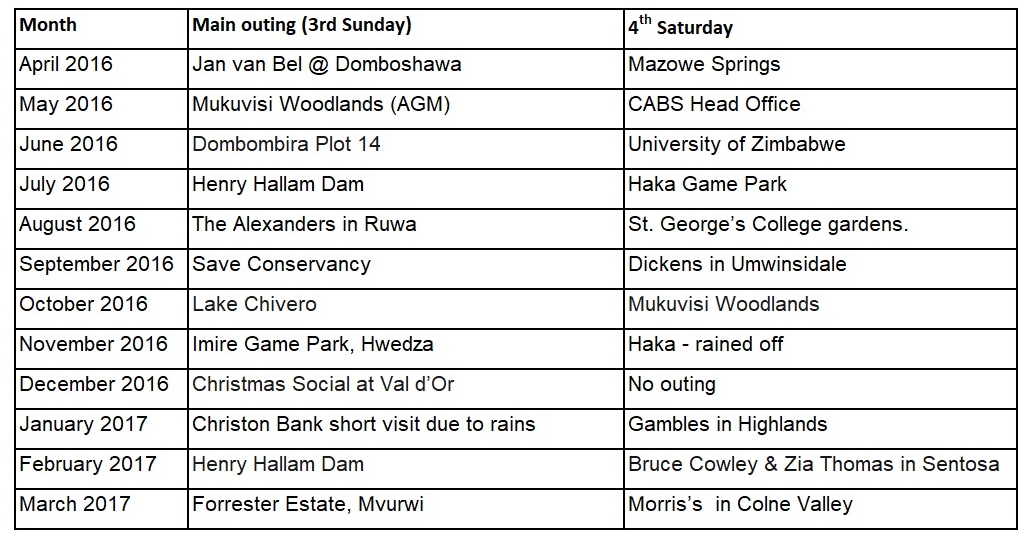
Week end outings: In addition to the regular monthly outings, there was a weekend trip to Humanii Ranch from 16th to 20th September, 2016. This visit to the Save Conservancy was organised by Mary Lovemore and was attended by 18 people. We were fortunate to have three “gurus” present on this trip – Meg Coates-Palgrave, Mark Hyde and Karl Van Laeren. I feel that with so much new stuff to see, we would have floundered without them. This was a really good trip and straight after the AGM we were treated to a photographic presentation by Dave Hartung.
Tree Leaders: I would like to thank Meg Coates-Palgrave, Mark Hyde, David Hartung and Tom Muller for leading us on many outings. I would also like to thank Karl van Laeren, Ann Sinclair and other new leaders who took over some of the load.
Tree Life: Isla Grundy has had a difficult year as editor of Tree Life and she has also been publicist for the Society. Sufficient material has not been coming in and we have had a serious shortage of Tree Life content.
Thanks to those who contributed write-ups on our outings and articles for Tree Life – in order of appearance: Isla Grundy, Mary Lovemore, Karl van Laeren, Ann Sinclair, John Meikle, Sarah Roberts, Meg Coates Palgrave, Mark Hyde, Dean Berry, Dave Hartung, Tempe van der Ruit, Ken Dixon, Bilal Khatri, Anne Butler & Dawn Siemers. The person who contributed the most by far was Mary Lovemore; she also contributed many articles from years gone by. Isla also contributed many articles. Without these two ladies, there would be no point in having Tree Life as it would be a one or two pager!
Bequest: In early November last year, we were asked by Jono Waters to manage a bequest by the late Mrs. Lottie Gyde for the National Botanical Gardens. After consulting Chris Chapano, we have decided to use some of it on the irrigation system so that we do not lose any more trees due to lack of water and the balance will be used to label some of the trees. The labelling of trees has begun and an irrigation expert has been consulted.
Finances: The accounts and balance sheet have been prepared by Bill Clarke. The financial position of the Society remains satisfactory.
Tree Society Facebook group: The group has shown an explosion of membership from 82 members in May 2013 to 2869 members on 6 April 2017.
Scanning back numbers of Tree Life: This exercise in re-typing Tree Life(s) from 1994 and earlier years is being undertaken by Mary Lovemore. Eventually, these will appear on-line. Many thanks for Mary for undertaking this mammoth and time-consuming exercise.
Tree Society web page: This is something we know must be updated and will happen very shortly.
Herbarium fumigation: Fumigation of the National Herbarium was carried out twice in the last year by Fumigation Services.
Christmas Party: once again we held an excellent Christmas Party at Val d’Or. Bill Clarke ran a scavenger hunt including thirty trees and we had three teams participating. Thanks to Adele Hamilton-Richie who ran the quiz with both general knowledge and tree questions. Thanks also to our hosts, Bill and Fiona Clarke – a good time was had by all!
Membership: As at 31 December 2016, we had 120 members, of whom 95 were ordinary members, 6 honorary and 19 external.
Committee: Since the last AGM, there have been no changes. The current committee consists of the following seven people: Isla Grundy, Bill Clarke, Teig Howson, David Hartung, Mary Lovemore, Bilal Khatri and myself. My sincere thanks go to the members of the Committee for their hard work and support on behalf of the Society. A big thank you to Mary, she has done the most work in the past year for the Society.
In conclusion …
The Society is in a strong position in terms of its finances and its membership. 2016-2017 was a successful and active year for the Society. Long may it continue!
-Tony Alegria Chairman
OUTING TO THE BVUMBA 5th – 8th MAY 2017
Whilst we were at Humanii Ranch in September last year Tempe van de Ruit had an idea of a much more active Tree Society expedition to the Vumba, where Tempe and Doug have a cottage and which is an area that is loved by all. Tempe’s idea was that we would be divided into two groups: one for the serious botanists, the lame and the more aged, and the other for the more energetic souls which would do a good long walk, admiring the trees and the views. Then the two groups would rendezvous at a given point. The idea was taken up enthusiastically and we had 26 participants on the trip.
Tempe, together with Sue Ingram, who lives at the Vumba and is an active member of “Friends of the Vumba”, got together and arranged a really wonderful itinerary for the weekend. All participants made their own arrangements for accommodation, which was made easy by Tempe who gave us a comprehensive list of what accommodation was available and at what cost.
All participants, and a few others, gathered at Seldomseen for a very cheerful convivial on Friday evening where Bilal excelled in providing us with delicious braaied chicken. A jolly evening during which Tempe and Sue gave us an outline of the plans and routes for the next two days and also the aims and ambitions of the “Friends of the Vumba” a really worth while venture in conserving the forest and the wild life of the Vumba forests.
We all gathered at Bunga Forest on Saturday morning. The fit and strong set off through the forest on a three-hour+ walk to George’s Point while the botanising group went into the Bunga Forest to explore. When the walkers were back we made our way by vehicle to George’s Point where we met up with the botanisers who had only just arrived.
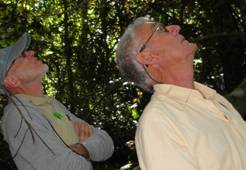
Jan van Bel and Peter Buttress trying to identify Photo: Dawn Siemers
There we were struck dumb by the beauty of the place, the views the Brachystegia spiciformis forest and the rock formations. It was wonderful. We had a leisurely picnic lunch and short walk to another spectacular viewpoint and then made our way to Vumba National Botanical Gardens/ Manchester Gardens where we had a lovely walk and all were impressed at the way the keepers of these gardens are managing to maintain a high standard on such a minimal budget.
There followed a cosy evening around a big log fire. Next morning we met at Leopard Rock Hotel where the energetic group set off on their walk and the rest of us were supposed to have a leisurely walk through the forest. The guide got his instructions a bit wrong and led the group up the mountain behind the hotel which became a major marathon! All survived to tell the tale and tea and scones and cream on the balcony of the Leopard Rock Hotel helped ease the pain.
Picnic lunch followed on the lawn of Sue and Mal’s beautiful home below the Vumba National Botanic Gardens – the view was breathtaking and it was difficult to tear ourselves away for the next leg of the expedition – a walk in the forest behind Tony’s Café and then tea and cake at Tony’s. Enough said! Then it was time to make our goodbyes and wander back to our various accommodation – big log fires and good company – a perfect ending to a great weekend.
Our very sincere thanks to Sue and Tempe and Doug for all their input.
-Mary Lovemore
Walk in the Bunga Forest 6th May 2017
Exercise, botanising, cheerful banter on our Tree Society visit to the beautiful Bvumba Mountains!! We all met for our first morning walk on a clear, warm day. At the Bunga Forest gate 10 of us decided to follow Wellington, our guide, on the longer and more strenuous walk which took over 2 hours, with frequent stops along the way as one or other spotted something of interest.
As we entered the forest I was struck by the slightly musty but clean smell of forest damp and spongy compost under our feet. The canopy above allowed occasional dappled sunlight and blue sky through but generally gave us a beautifully cool and shaded walk, much appreciated when we negotiated some of the steeper climbs. There was little undergrowth in much of the forest apart from saplings, allowing us to see well beyond the pathway, and spot some of the other little gems of interest.
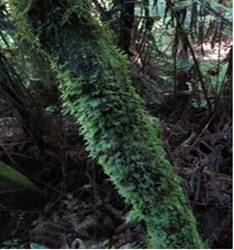
Many of the trees had a variety of fern and moss growth. Photo: Jenny Mackay
The variety of ferns and other forest plants struck me in particular, perhaps because my eyes were more glued to the ground to avoid tripping on little protruding stumps and creepers which threatened to hook one’s feet out from underneath one. My walking pole was very well used. Many of the trees had a variety of fern and moss growth on them, so green and beautiful, and we spotted the odd tree orchids too, unfortunately without flower.
In one of my few moments when I did look up skywards I spotted some red flowers way up above in the sunlight, precipitating much discussion amongst those in the know. It was eventually identified as a Manica Beech (Faurea rubriflora) apparently taller than usual, perhaps because of the thick forest through which it had pushed upwards.
Our next tree of interest, and off the beaten track, was the Soccer or Football Fruit tree (Tabernaemontana stapfiana) spotted by the big green ball lying on the ground, with a few more on the tree itself.
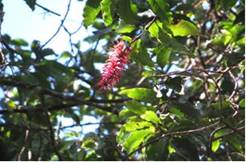
Faurea rubriflora. Photo: Jenny Mackay
And so we pressed on, eyes to the ground again and there growing on an old piece of dead wood was a sizeable stretch of pristine fungi, a stark contrast to the surrounding forest greens of moss and fern, another reminder of the on-going life of a fallen tree.
One of our main aims was to reach the Spiny Tree Fern forest, a steeper downward walk to a small rocky mountain stream surrounded by so many of these giants. We were not disappointed. And yes, spiny indeed as I found out when reaching out to support myself on one of them. Ouch.
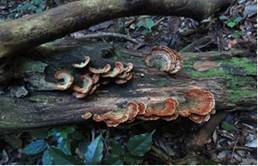
another reminder of the on-going life of a fallen tree. Photo: Jenny Mackay
It was a steeper but manageable climb upwards again, still cushioned by the thick bed of damp leaf mould. Further up we peeled off the track to try and find a waterfall supposedly nearby but after another downward slide we found only another mountain bubbling brook, a very pleasant spot where some of us drank the clear mountain water, or filled water bottles.
And so we pressed up and on, eventually and suddenly to pop out from the cool dark forest into open grassland and bright, hot sunny skies, and mountain views across the valleys.
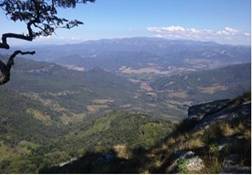
View fromGeorge’s Point. Photo: Jenny Mackay
Thankfully a pathway had been semi cleared for us through the thick knee high grass as we made our way across to our designated meeting spot at George’s View, to share a picnic lunch with the rest of the group who had opted for a less strenuous tree walk followed by a drive to George’s View.
And finally another short walk to the viewpoint overlooking another valley and the Broccoli Forest. Altogether a most enjoyable morning spent in one of Zimbabwe’s many beauty spots.
Marina remarked that the Vumba was so very much like New Zealand and recently another friend touring in Portugal had sent photos reminiscent of Vumba. No need to travel when we have so much of our own beauty to explore and enjoy.
– Jenny Mackay
More on the Bvumba Outing 6th and 7th May 2017
After much umming and arrrring my brother Dave Hartung finally persuaded me to head for the Bvumba along with faithful members of the Tree Society.
The braai that first evening was extra special and I feel Bilal ought to be issued with a proper chef’s outfit with ‘Tree Society Special’ embroidered thereon. Thanks too to the silent ladies in the kitchen who produced other delicious, mouth-watering cuisine.
Arising next morning to the aroma of hot, freshly ground coffee percolating on an open fire, plus lungfuls of mountain air, it was with great enthusiasm that nine of us set off behind Tempe (at a trot) through the magical Bunga forest. Oh what trees, some of which to my amazement I did know and I did learn one or two new ones. I was fascinated by the ‘football tree’ – at first I felt those knowledgeable folk were pulling my leg!
The Samango monkeys kept out of view which was sad (but we were lucky to view these at our lodgings) and there was much evidence of blue duiker, but again not viewed. I was amazed at the crystal clear, tinkling stream crossing in the Spiny Forest where the magnificent stately tree ferns were not really people friendly, with their evil, prickly trunks and therefore to be treated with immense respect.
After several hours of walking on the mulch floor of the forest, admiring the long, the short and the climbing, the troupe broke out into a sunshine-filled, grassy plateau where we stood breathless at the beauty and vastness of the Burma Valley, with far off mountains forming a backdrop.
Lunchtime was restful under the little Brachystegia outcrop at George’s Point with good old granite rocks to perch upon. The views and precipitous cliff face, looking down on the “Broccoli Forest”, are something to hold in our memory forever.
Sunday morning saw two groups again setting off from the rear of Leopard’s Rock Hotel. Well, that was quite a walk and fairly hectic climb to the base of the great rock itself. Goodness me, what a magical place and I couldn’t help thinking one of Enid Blyton’s ‘Enchanted Wood’ characters might appear at any moment! Another wonderful walk and experience led by Tempe, then back to the hotel where we were spoilt with tea, coffee and fresh scones with trimmings – wonderful place.
The other group had opted for the so-called short easy walk, the first part of which turned out to be more like a mountaineering expedition through the forest. Up front Meg did very well with some help on the really steep and tricky bits from the guide and Graham or Jan, while at the rear Sue, suffering from a painful foot and wielding a huge alpenstock, was regularly hauled upwards by Dave. They eventually came out onto the relatively level ground of the superb golf course, where they had more time & inclination to actually look at some of the trees before joining the first group for tea at the hotel.
How good it was to see that, with so few resources available, how much effort National Parks staff were putting in to try and maintain the vast area of the Botanical Gardens. To keep tidy the area of azaleas alone was mind-blowing. Winter aloes were at their best and stunning in the bright sunlight. And of course, Sue Ingram’s garden. Well, what a place to live – thanks for sharing the beauty with us.
Then finally to Tony’s tearoom. Oh yes, very special and even those who declared they didn’t have any intention of eating had no choice but to succumb! Irresistible.
Thank you to all those who organised yet another great outing. When is the next trip?
– Zilla Batchelor
OUTING TO DOMBOMBIRA 27th MAY 2017
The weather was fine and after leaving the hectic city traffic and turning off onto a 7km dusty road, we arrived on the outskirts of Ruwa. Dombombira Plot 14, a dreamy piece of woodland with many trees harmoniously interspersed by rocks weathered over millions of years, standing as giant guards. The many bushman paintings are witness to a once- populous society in an agreeable habitat a long time ago. The place is now being used for social functions as weddings and school trips. It is run by Wendy and her husband Rob.
We parked in the shade of a big litchi tree. It was close to three o’clock and we counted seven people. We were welcomed by the owner and his wife, as well as two workers in tow with pen and paper to record trees for labelling later. This was for some of us the second visit to this place and some trees had already been listed in a previous outing about a year ago. The owner had requested more trees to be identified and Tony, our guru for today, was very obliging. We started reading the woodland with a pace that left no time for legs becoming locked, steady and purposeful and still enjoying the stroll on the cleared easy paths between rocks and trees.
We recorded 53 trees. Most remarkable was the profusion of Dombeya burgessiae (flowers here rather white than pink), here and there flanked by Erythroxylum emarginatum. Remarkable also was the absence of Musasa. We did not even see one, but several Julbernardia globiflora (Munondo). Many Euclea natalensis, Ochna puberula, and Steganotaenia araliacea, the Carrot tree. For me, the number of these was also unusual.
Some exotic trees were also recorded: Eucalyptus citriodora (Corymbia citriodora) or Lemon Eucalyptus. Tony also directed our attention to the dry leaves which, remarkably, still gave off a strong citronella smell after crushing. Only a few minutes before we had been able to smell the small shrub Lippia javanica (Lemon Bush) next to a Grevillea robusta, a large Australian tree with attractive bipinnate leaves, not uncommon in Harare. Other exotics: Belhambra (Phytolacca dioica) an impressive invading tree with fruits like a giant mulberry (also called monkey grape), Ulmus parvifolia (an Elm) and Macadamia.
During the walk our attention was also attracted by the red fruits of a Pterolobium stellatum and the hockey-stick pods from Indigofera rhynchocarpa. Also good to see was a rare Turraea nilotica. As a diversion we wandered over to the aviary and an enclosure with rabbit and guinea pigs, a welcome distraction for visiting children.
Here is a list of all other trees seen and named: Albizia antunesiana and A. gummifera, Vangueria infausta, Vangueriopsis lanciflora, Azanza garckeana, Ximenia caffra, Pavetta gardeniifolia and P. schumanniana, Ziziphus mucronata, Ozoroa reticulata, Dichrostachys cinerea, Gymnosporia buxifolia and G. senegalensis, Erythrina abyssinica, Clerodendrum eriophyllum, Ficus burkei, Grewia monticola, Strychnos spinosa, Celtis africana, Flacourtia indica, Cussonia arborea, Diospyros lycioides, Combretum molle, Canthium lactescens, Ochna puberula, Searsia longipes, Vitex payos, Rhoicissus tridentata, Euclea crispa, Khaya anthotheca, Maytenus undata, Flueggea virosa, Dombeya rotundifolia, Terminalia sericea, Senna singueana, Pseudolachnostylis maprouneifolia, Grewia stolzii, and lastly Callistemon viminalis.
As we had started a little late because of the distance from Harare, it was now time to return. We were satisfied and had seen more than expected. The two workers had to search for the donkeys to bring them in and we also wanted to be home before dark.
-Jan van Bel
TONY ALEGRIA CHAIRMAN


